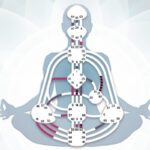The topic of conditionality in Human Design comes up very often in Human Design. This term literally means the constant energy exchange that occurs between us and the people around us. It is a constant, dynamic process, and it is in no way dependent on our will. We influence our friends, neighbors, coworkers, and even people passing by, just as they influence us. And the results of this influence can be the cause of your good or bad mood, a source of wisdom or lead to disappointment. It all depends on whether you know how to work with the energy of others correctly, or whether you are letting it unknowingly program you.
Even the most hardened loners cannot completely escape conditionality. A simple trip to the store can already impose a whole prism of “uninvited” states and emotions, inspired by other people and their energy. Normally, the Mind always perceives encroachment on its personal boundaries as something negative and tries to avoid it. Therefore, for many people, understanding the mechanism of conditionality can be an extra reason to avoid meeting and communicating with others. But is it really that harmful?
Ra Uru Hu, the founder of the teachings of Human Design, personally said that there is nothing harmful about conditionality and there is no point in fighting it. We can’t escape from other people anywhere if we want to, and all we have to do is learn to live in a way that uses other people’s influence to our advantage. It is important simply not to identify with other people’s conditionality, but to see it as exactly what it is: a temporary effect, brought on by someone from the outside. As they say, you cannot prevent birds from flying over you, but you can prevent them from making a nest on your head. All the more, with the proper skill and level of self-awareness, conditionality can be used for your own benefit.

So let’s try to clear up the misunderstandings that are caused by questions about conditionality. We all have our own “themes” in which we are vulnerable to the influence of others. In the Bodygraph, these places are marked as indeterminate Centers, and it is in these places that we can expect to be specifically influenced. That is, just knowing the peculiarities of one’s own Bodygraph would be enough to correctly perceive conditionality and be ready for it.
On the other hand, the places marked by certain Centers are what you and other people use to influence others. And it is very interesting to realize, that not only you may be a “victim” of someone else’s influence, but also yourself, sometimes without even being aware of it, may influence the people around you. So if people around you say that you are so-and-so or so-and-so, it is a reason to think about why this particular theme is manifesting itself in your life. It’s possible that you just surround yourself with people with the same indefinite Centers and the way they perceive you will be completely different for others.
It’s worth realizing that every undefined Center in your Bodygraph is an opportunity to gain great wisdom. If you learn not to be blindly “led” by other people’s influence, but to use this opportunity consciously, it will significantly increase the level of your life. For example, if a person has a certain Throat Center, he will be very persuasive in his speech and can use this skill to teach other people. But if he has an undefined Root Center, a source of adrenaline and inner “fervor” and inspiration, he will have difficulty working for long distances. In this case he would just have to “calculate” students with a certain Root Center, interact with them, and use their energy in his work. I think each of us has noticed that with some people we feel ourselves full of energy, while with others we want to yawn and not talk at all. These are all different manifestations of conditionality.
Now to summarize. Conditionality is not your enemy, but an ally that you must use wisely. Very many people have a negative attitude to the very concept that someone has the power to influence them from outside. and often even total strangers. So they “resist” them with all their might, tormenting both themselves and those around them by trying to behave differently than they really want to. Even if it were possible to completely get rid of someone else’s conditionality, it would be a very boring, static life, in which the feelings of each day are similar to each other. No drive, no emotion, no development, just a dead emotional plateau.
So just accept conditionality as a given, without trying to fight it. That way you’ll be able to not only know yourself much better, but also to “use” other people to fill in some of your shortcomings. Everything is in your hands.
A full decoding of your chart in pdf format is available here.



